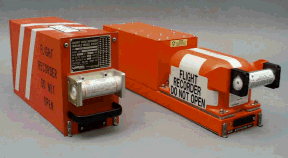
What is a black box made of? There is no one single material, but they have to be able to survive any of the conditions that a crashing aircraft might encounter.
We call them black boxes, but they aren’t actually black. In fact, a literally black black box would be very hard to find. They are painted bright orange so that they can be found easily. Many safety devices are colored orange because it is a very visible and attention grabbing color for us. People searching for a black box amongst wreckage will have more chance of finding it if it is orange than any other color.
The term black box possibly comes from Britain during the Second World War. Planes were fitted with radio, radar, and navigational devices to help them fly around and locate enemy aircraft. The Germans didn’t realize how important radar would be until a few years into the war, and the Allies wanted to keep their technological advances secret. To that end, all of the radar equipment was housed in a black box in the front of the plane in the hope that it wouldn’t be found if a plane crashed. The name “black box” for these recorders was first used in Australia in 1960, and when they were mandated worldwide in 1967, the name “black box” continued to be used.
We have already looked at how safe air travel is, and that the majority of plane crashes that do happen are survived by the majority of people. Still, planes do crash, and an important part of any air crash investigation is to work out why it happened. The causes of a plane crash can always be used to make other airplanes safer. The problem is, in the very few plane crashes that do result in large numbers of casualties, they often explode on impac,t and there is very little structural evidence to go on. That makes the information on the black box enormously important. There are two sources of data that are recorded. The first is all of the parameters of the aircraft: speed, altitude, position, acceleration, heading, engine information, and information from many other sensors. They can record thousands of points of information. The Airbus A350 and the Boeing 787 log over 25,000 parameters. This is the flight data recorder, and it will record about 25 hours, which is more than enough for most flights. The second data source is the cockpit voice recorder. This records roughly the last 2 hours of conversation in the cockpit and can give investigators clues as to what was going on. This used to be done using a looped cassette tape, but these days they use solid-state memory because it is stronger. These two devices are sometimes combined into one and sometimes separate devices.
To make sure all of this data survives until it can be found, there are several requirements that the black boxes have to meet. The first is strength. They must be able to survive an impact of 3,400 G for 6.5 milliseconds, a perforation from a hardened steel spike of 225 kg dropped from 3 m, and a crush test of 2,300 kg. To survive this, they are usually made of an aluminium and stainless steel alloy. It is resistant to fatigue and corrosion and is extremely strong and dense. They are then covered with an outer layer of armored steel. Obviously, no material can be completely destruction-proof, but these are some of the strongest materials available. The black box then has to be able to survive a fire of up to 1,100 ℃. If a plane crashes, the fuel will often ignite, and the black box needs to be able to last until the fire goes out. There is a layer of thermal insulation between the layers of the box and inside the box as well. And they must be able to survive being underwater and deep-sea pressure. They are waterproof, but a crash can damage seals. Old tape recording systems could be damaged underwater, but modern solid-state memory devices are much more able to survive. They are rated down to 6,000 m.
Finding the black box in the event of a plane crash is also important. They don’t have a GPS locator because that would need an aerial to the sky, and that could compromise the strength of the box. They do have an underwater locator beacon that is activated on contact with water and pings for up to 30 days. It sends out an ultrasonic ping that can be detected and that will travel a long distance in water. When a plane crashes on land, the wreckage can usually be discovered, and the black box will be somewhere in the wreckage, usually. When a plane crashes in water, they are harder to find.
In the future, black boxes might be replaced by a constant satellite uplink of data. There is a worry that anybody could access the data, but it seems like a logical step. And this is what I learned today.
Sources
https://easbcn.com/en/airplane-black-box-what-it-is-and-how-it-works
https://www.grupooneair.com/what-is-black-box-aeroplane
https://en.wikipedia.org/wiki/Flight_recorder
https://www.verywellmind.com/the-color-psychology-of-orange-2795818
https://aviation.stackexchange.com/questions/2655/why-dont-black-boxes-have-their-own-gps
Image By Dennis R. Grossi – http://www.ntsb.gov/Events/symp_rec/proceedings/authors/grossi.htm, Public Domain, https://commons.wikimedia.org/w/index.php?curid=6232258
